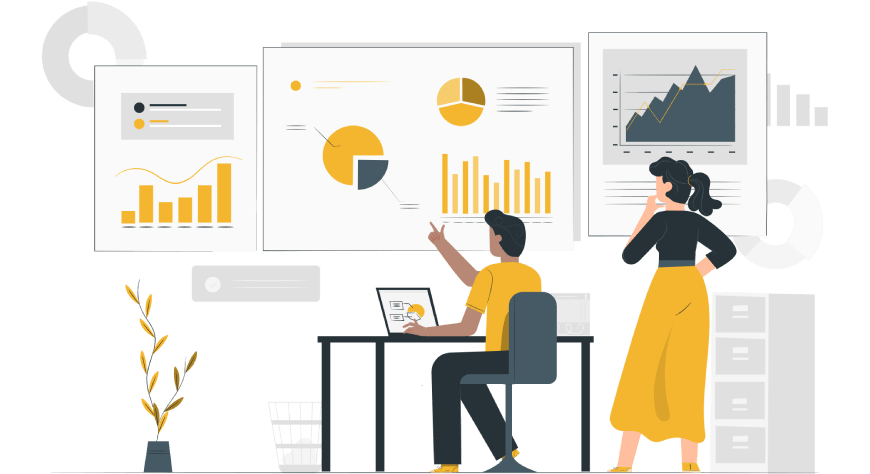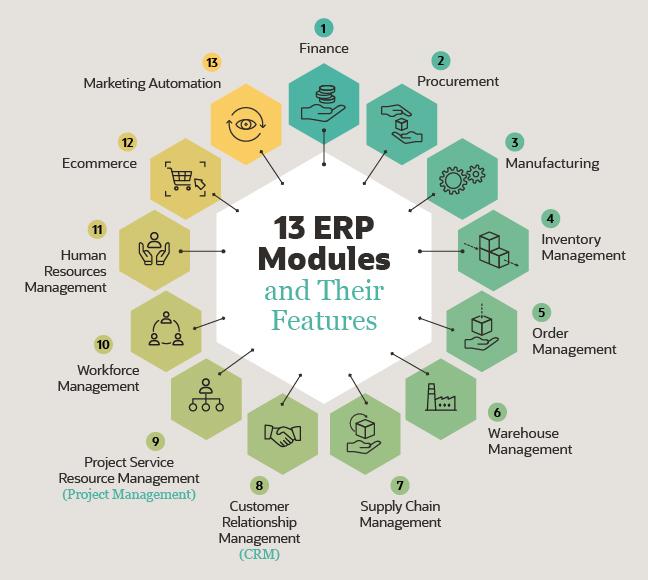
In 2020, the world learned how easily and unexpectedly things can go wrong. To stay afloat in specific conditions created by the pandemic, business owners had to adapt quickly to market changes. Flexibility and foresight became crucial factors for their success. Indeed, the global enterprise resource planning (ERP) market was estimated at $43.09 billion in 2020, and experts believe that it can grow to $70.77 billion by 2026. The market is expected to expand on average by 8.66% every year during 2021-2026. Using ERP during the pandemic guarantees smooth operation of the enterprise: 95% of companies have already improved their business processes by implementing the system. In this article we discuss the methods of business forecasting, highlight the advantages of ERP systems, and recommend on their setup and use in the planning of procurement, supplies, demand, sales and other manufacturing operations of the company.
Why is business forecasting necessary?
Business planning is mainly focused on identifying the dynamics of the factors that influence the existing market environment. In their 2020 survey, MarketsandMarkets showed that using analytics tools helped the companies make decisions during problem situations 5 times faster, execute plans 3 times more efficiently, and, at the same time, increase their profit by at least 2 times. With the help of forecasting methods, businesses get the opportunity to prioritize properly: to plan the needed resources carefully and allocate the efforts wisely.
Types of planning by time coverage (forecast horizon)
- Short-term – prevents the majority of negative events (bankruptcy, recession, etc.) and regulates the company’s financial flows (weekly, monthly, yearly);
- Medium-term – registers the amount of investments in fixed capital and terms of creation of innovative projects and new products;
- Long-term – determines financial expenses for capital projects and improves the mechanism of asset management in the company.
What are the forecasting methods?
Forecasting methods are some specific sets of techniques and ways of executing prognostic operations. They differ by the types of data used in the process of analysis, and also by their advantages and disadvantages. There are a lot of methods of forecasting, but only a few of them are used in practice.
Statistical forecasting
Statistical forecasting is the analysis of historical data over some long periods in the past. This method is good for markets with stable demand. The planning is performed manually based on the analysis of data from the corresponding time periods (years). To create this type of forecast, most companies use basic programs that are no longer relevant. Veeam 2020 Data Protection Trends Report indicated the fact that outdated technologies constitute the main challenge to implementing digital methods of business process management. The advantages of traditional forecasts are the following: the value of historical data which may be necessary for medium- or long-term planning; their significant role in forecasting the total demand for products. The disadvantages include: high probability of error; only historical data analysis is performed; low accuracy of results; using simple theories for data entry; using data only about past events; high cost in terms of manpower and time.
Machine learning (AI)
The method of intelligent forecasting enriches the possibilities of analytics due to the different sources of information. These are macroeconomic indicators, statistics, surveys, financial reports, social media activity reports, etc. Mathematical models are applicable to markets that are constantly changing. This method is recommended for short- and medium-range planning, as well as for projects related to launching new products and advertising campaign planning. According to PwC’s 2017 survey, 50% of companies named the lack of automated tools as a serious problem for forecasting. Modern ERP systems allow companies to automate internal business processes, and thus to analyze complex sets of data, minimize their redundancy and improve the accuracy of outcome indicators. Benefits of AI forecasting: quick automation of the process; high accuracy of planning; preparation of forecasts in a few minutes; generation of large volumes of information. Drawbacks: complex algorithms; inconvenient short-term forecasts (weekly, monthly); probability of false signals; high computing power of the server.
ERP and forecasting: what are the benefits?
According to Aberdeen Group, small and middle-sized organizations choose ERPs because they provide 48% real-time visualization of analytical and other data. This contributes to creating a single and unified reporting system for business processes. The ERP system generates analytical data at any time and eliminates the need to consolidate numerous spreadsheets manually, which is a time-consuming process. Increase in business efficiency and ensuring compliance with regulations together with automation of reporting are named as the reasons for ERP implementation by 17% and 14% of the respondents respectively.

Source: Panorama Consulting Solutions Research Report
The ERP systems’ advanced data analysis options, such as the built-in analytics, reporting and visualization of information, facilitate making important managerial decisions related to marketing, production and finances. MarketsandMarkets have found that businesses use real-time analytics tools to improve their asset allocation, reliability and flexibility of operations. If properly configured, ERP can process both structured and unstructured data in large volumes. With the advanced analytics tools, you can modify products when necessary, analyze market conditions and develop a strategy for the future. The fact that users of ERP systems get remote access to the data from different departments of the company makes it much easier to search for information and, consequently, accelerates the process of business forecasting.
How to set up ERP forecasting?
Most ERPs have the built-in modules for analyzing statistical data: modules for managing inventory, finances, supplies and purchasing, human resources, etc. Some modules allow to make forecasts based on the data obtained. Experts in the industry can both customize and develop the necessary modules from scratch, depending on the requirements and objectives of the company. Extracting information from particular sections and working with data synchronization algorithms are also the parts of forecasting setup.

Source: Oracle Netsuite
Need help with ERP setup?
Consult certified experts who will help you implement forecasting in your ERP system. Since 2015, FiduciaSoft has been providing the outsource services of setup, configuration, customization and development of ERP modules. Our experienced specialists work with the popular systems, such as Acumatica, Sage 100/300, MS Dynamics 365 and AX, as well as with other .Net-based solutions.
How to improve the quality of a forecast in ERP?
There are a lot of functionalities available in modern ERP systems. The user’s task comes down to mastering the proper use of these features. To make business forecasts more accurate, you should first learn how to collect and store large amounts of data. Additionally, it is important to master the related services and tools, in particular – the cross-analytics. You should understand that the quality of forecasts depends on the compatibility of the third-party services and systems (e. g. Google Analytics) with the ERP. It also depends on the reliability of the data received from partners (data on logistics, suppliers, production, etc.).
What can be forecast in ERP system?
The ability of a business process to be subject to forecasting is connected directly with the number of modules and their features. These features are determined by the ERP system manufacturer and by the needs of the business that uses it. Modern software solutions allow to introduce either full functionality or some particular modules. For instance, it is possible to add modules for quality management, project management, environmental management and many other aspects according to the company’s needs. Here are a few popular categories for planning in ERP.
Demand and sales forecasting in ERP
ERP determines the number of orders that the company may receive in the future. The projected figure is calculated on the basis of the past and recent results of the products, with the market competition being taken into account. Other factors that influence the analysis are seasonality, geography and the needs and expectations of target audience. The obtained forecasts may be used to set optimal prices and optimize sales processes.
Forecasting in logistics and warehousing
With the ERP system, the processes of inventory management as well as supplies and logistics management can be automated. This allows to minimize the risk of product shortage or surplus. Based on the data obtained, entrepreneurs can regulate the inventory and make decisions on goods delivery.
Forecasting in purchases
ERP systems help predict the prospective inventory needs and the required quantity of certain products. ERP procurement management interacts closely with supply chain management (SCM). The former allows to manage the warehouse and manufacturing logistics, purchases and suppliers, and forecast demand for products. To handle the procurement competently, it is necessary to have accurate data on the inventory balance.
Financial forecasting in ERP
Using the ERP tools, you can analyze future expenses and revenues, which is essential when planning the long-term and large-scale projects. The system facilitates optimizing cash accounting, calculating budget allocations and assessing the efficiency of the previous financial actions.
Forecasting in HR
The company’s workforce balance is as important as its financial resources. The ERP platform compares the number of employees who left the company to the number of currently working employees. Based on this information, ERP projects how many new workers the company will need to attract to achieve its objectives. The system also creates work schedules, maintains personnel records, calculates each employee’s salary and much more.
Situation modeling
The forecasting module in ERP analyzes the current situation on the market and identifies the external economic factors that may have a negative impact on the business’ competitiveness and shake its financial position in the future. Besides, it specifies the periods when the risk of difficulties is the highest.
How to set up or improve forecasting in the company?
ERP software offers a number of features that will help your company reach the next level. By implementing additional modules and adjusting the program to your needs, you will simplify the forecasting process considerably. Also, this will reduce the workload of the employees responsible for collecting and analyzing data and preparing forecasts. To ensure the successful setup of the ERP algorithms and integration of the system into the IT infrastructure of the enterprise, it is better to entrust this work to professionals. Correct installation and customization of ERP is an important step on the way to improved accuracy of planning.
